Poison ivy (Toxicodendron radicans) is a noxious weed commonly found in home landscapes, along roadsides, in forests, and even in urban areas in North America.1 Its toxicity is based on an active irritant called urushiol, an oily resin in all plants’ parts. Pets are less likely to be troubled by poison ivy but are occasionally affected by it.
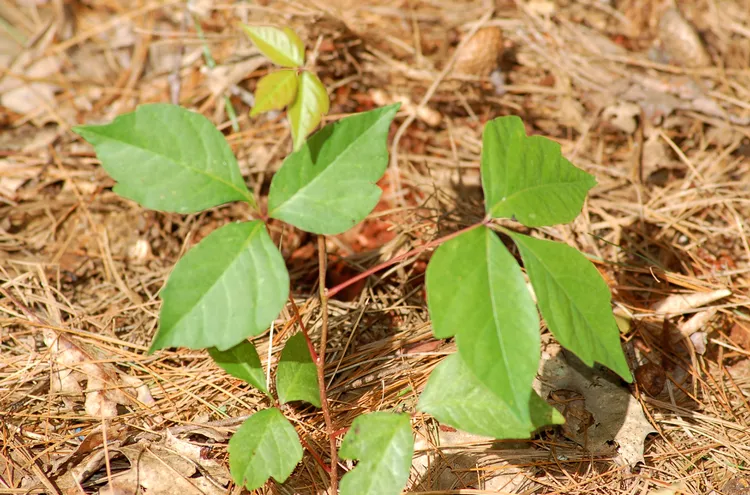
The scientific name of the plant is Toxicodendron radicans. Knowing the old rhyme of “Leaves of three, let it be” may be the easiest way to tell if it might be poison ivy, but you need more information to be positive. These photos will allow you to identify the plant, both with and without leaves and at various stages of maturity.
While the leaves are the most toxic part of the plant, contact with any part (even when the plant is bare of foliage) can be toxic to you. Even if your cat or dog comes in contact with the plant, the animal can spread it to you.1 That is why it is essential to learn how to tell what poison ivy looks like throughout the growing season and beyond. This leaf close-up shows plants less than a foot high but already put on their green summer color.
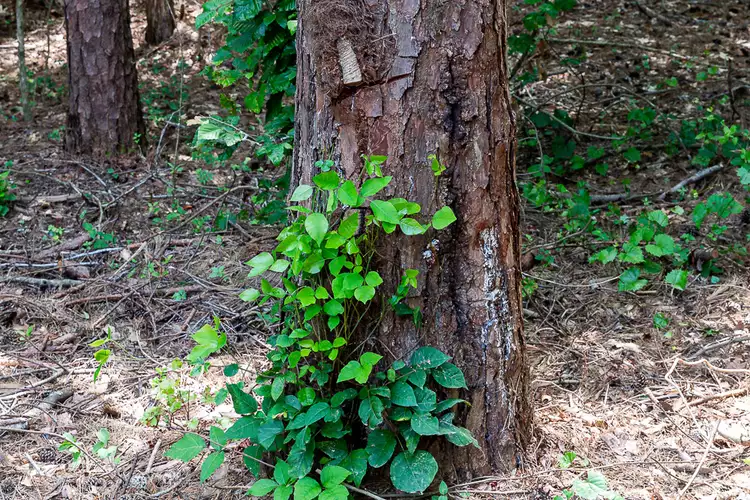
Where Poison Ivy Grows
Poison ivy is native to the eastern United States and eastern Canada; therefore, by definition, it can’t be considered invasive there, even though it spreads aggressively even in that region.1 But it could be invasive in regions to which it has been introduced. Poison ivy is not fussy about sun and soil conditions, which is one reason why it is such a successful weed.
Virginia creeper (Parthenocissus quinquefolia) is commonly mistaken for poison ivy since it’s another vine that often grows in the same places. The difference between Virginia creeper and poison ivy is that it often grows in groupings of five leaflets. Similarly, both plants have a reddish center where the leaflets join. Also, Virginia creeper vines are much less hairy than poison ivy vines.
At first glance, box elder (Acer negundo) seedlings grow as three leaflets, which can look like poison ivy. The significant difference is box elder leaves, however, are arranged opposite each other, not alternating like poison ivy.
How to Identify Poison Ivy
Leaves of Young Plants
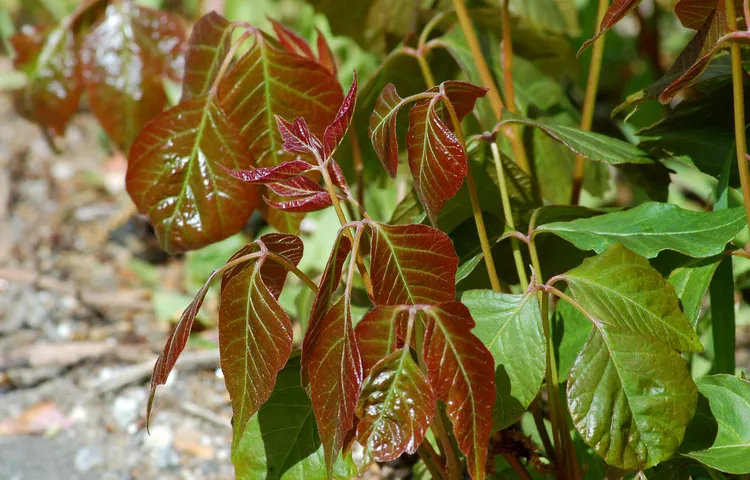
Young poison ivy plants often start in spring with orange or reddish leaves. Be aware that the margins of the leaves sometimes have notches in them (but not always, so this feature, in and of itself, is not enough to identify the weed). The plants here are just barely off the ground, but the oil (urushiol, which makes this plant toxic) can still rub off on the fabric of shoes and socks. It is possible to transfer the oil from your clothes to your skin, so be careful removing the garment if you think it came into contact with poison ivy.
Mature Plants
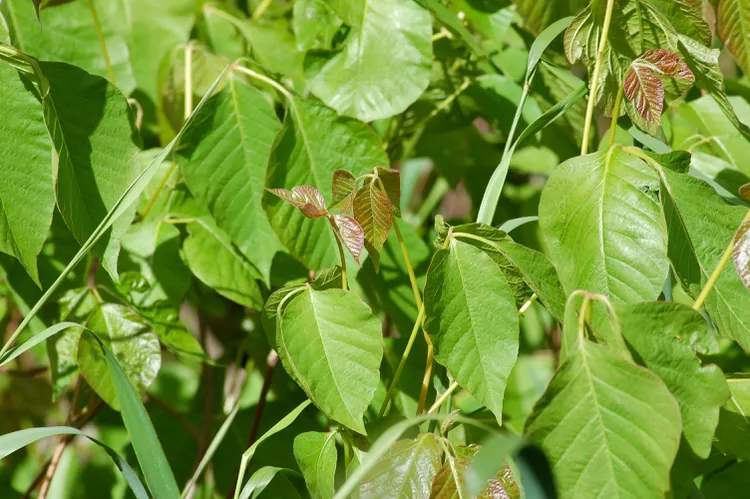
As summer progresses and poison ivy plants mature, most of the leaves are green and about two feet high. Any new leaves that appear will still be reddish, as in spring (but the red color will not be as intense). Poison ivy vines often grow in a mass, taking over an area and becoming the dominant plant.
Flower Buds
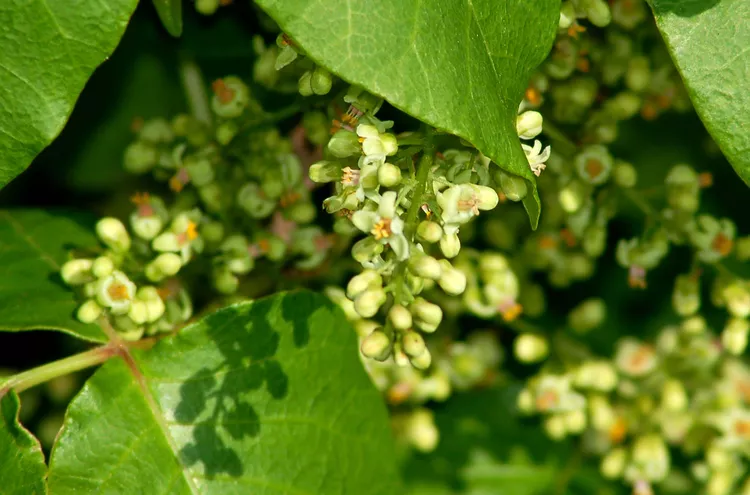
People seldom associate something as nasty as poison ivy with flowers, but it blooms. The blossoms are not especially attractive. The flower buds, which form in clusters, look like tiny specks of green if you are just glancing quickly at the plant.
Flowers
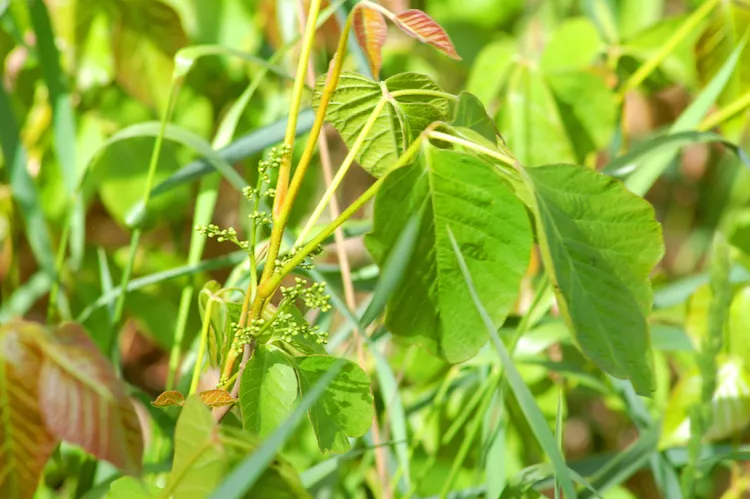
Poison ivy produces relatively small, unremarkable off-white blossoms with orange centers. Unopened buds that are close to opening are also off-white. You will sometimes see a plant with both opened and unopened flower buds simultaneously (as in this example). Walking quickly past a patch of poison ivy plants in bloom, you would hardly notice the individual blossoms.
Berries
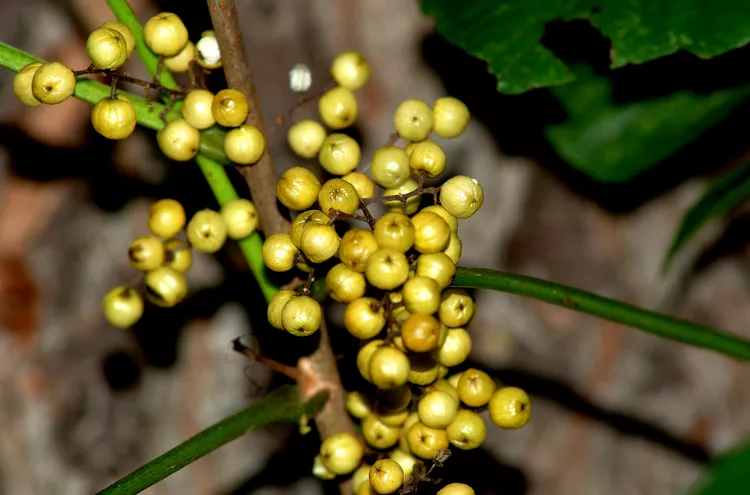
Poison ivy plants also grow berries, which are just as toxic as the rest of the plants.1 An identifying trait of poison ivy is the color of its mature berries. They turn from a pale green to a whitish color when they ripen (in late summer to early fall). Poison sumac also has a curious white berry.
Fall Foliage: Orange
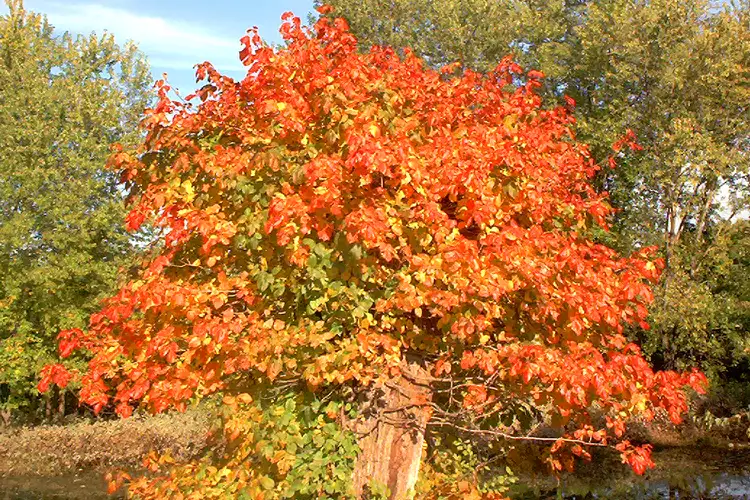
The green summer color of poison ivy’s foliage yields brilliant fall foliage in red, yellow, or orange. The autumn brilliance of poison ivy’s foliage is due to the anthocyanin pigments characteristic of the plant family to which poison ivy belongs. Poison oak and poison sumac turn similarly colorful shades in fall. All three plants are members of the cashew family (Anacardiaceae). The color in autumn is as breathtaking as it is on any of the trees grown for their colorful fall foliage.
Fall Foliage: Red
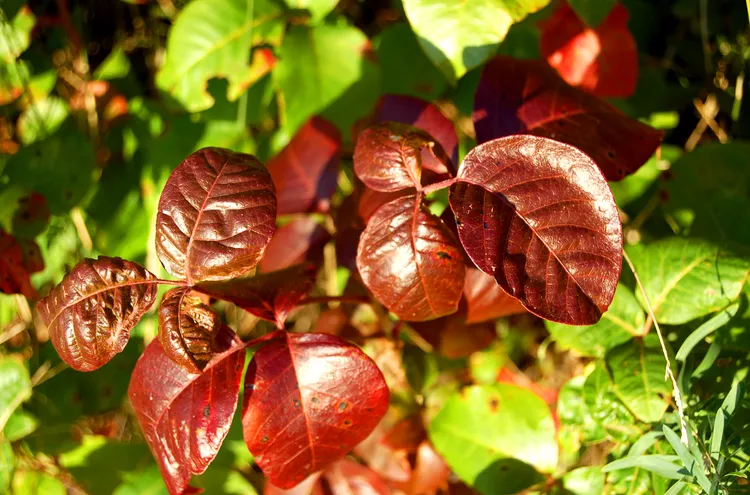
If poison ivy sprouts in the spring with red leaves, they often display reddish fall foliage. In this regard, poison ivy is a lot like red maple trees that show red buds in spring that are a preview of their gorgeous red fall foliage.
Aerial Roots
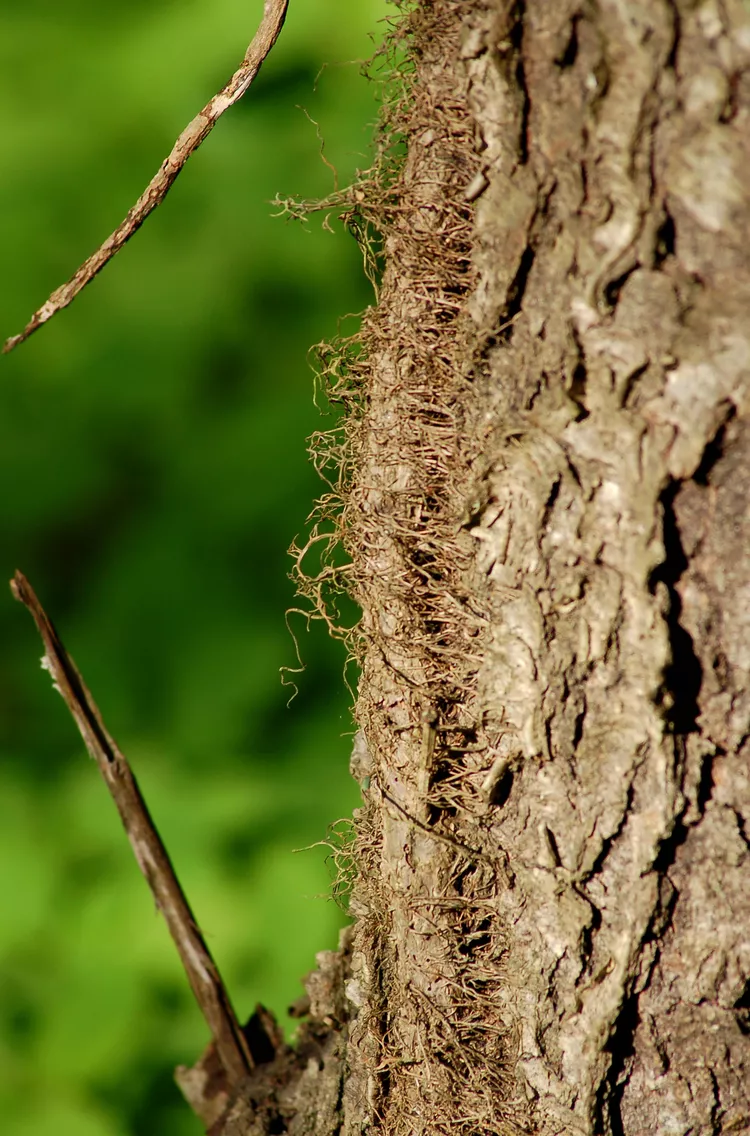
You may have seen hairy vines climbing up trees or bristling along the tops of logs resting on the forest floor. The “hairs” are the vines’ aerial rootlets. That is what poison ivy looks like in winter after the old leaves have fallen off and before spring’s new leaves can take their place.
Rootlets are why trees, tree stumps, and stone walls are covered in vines. Rootlets can cling to surfaces, allowing the vines to climb. When poison ivy has been climbing a tree for a long time, the vine can become so embedded into its bark that it essentially disappears, with only the rootlets visible.
The Vines Can Damage Clapboard
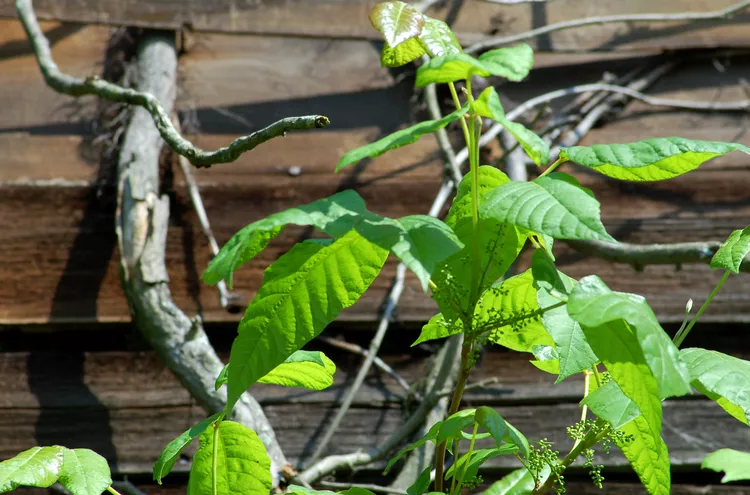
Winter’s “hairy” vines are as toxic as the rest of the plant during other seasons.1 Poison ivy vines can climb up the walls of buildings. If they are allowed to climb up the side of a house, garage, barn, or outdoor storage shed sided with clapboards, they can wreak havoc with the clapboards over time, necessitating repair work.
How to Remove Poison Ivy
You should remove poison ivy from your property, so you don’t accidentally make contact with it while gardening. It is possible to eradicate poison ivy safely, whether organically (manually) or with herbicides, but you must take extreme precautions, which might take several attempts.
When working around poison ivy, it’s essential to wear gloves (wash the gloves and your clothes separately afterward from your other laundry) so that any residue you came in contact with isn’t transmitted to your food, face, pets, other people, or any other surfaces.
Identifying Poison Ivy vs. Poison Oak vs. Poison Sumac
Poison ivy and poison oak are more alike than poison sumac. They each look like they have three leaves per stem. Each leaf (or, in this case, leaflet) is 2 to 8 inches long and 1 to 5 inches wide. They have teeth along the edges of the leaf. The difference with poison oak is the teeth appear rounded, more like a rounded or bulbous common oak leaf; meanwhile, poison ivy teeth edges appear more pointy. Also, for poison ivy and oak, the juncture where the leaflet joins at the stem is often reddish.
The growth habits of poison ivy and oak are different. Poison ivy grows like a vine along the ground or up the sides of trees or structures. Poison oak grows like a shrub with leaves atop longer, upright stems. Like poison oak, poison sumac grows like a shrub or small tree. It can grow up to 20 feet tall and is often found in wooded, swampy locations.
A similarity poison sumac has to poison ivy or oak is its stems are red—more than poison ivy and oak. Also, they all produce white berries. Beyond that, poison sumac leaves look very different. Each leaflet is oblong with sharp, pointed tips and smooth edges. The leaflets do not group in threes. Instead, you can expect to see seven to 15 leaflets lined up in pairs; each leaf is about 2 to 4 inches long and 3⁄4 to 2 inches wide.


These poison ivy pictures and identification tips are incredibly informative! I appreciate the detailed descriptions of poison ivy’s distinctive features, such as its three-leaf arrangement and serrated edges. The comparison images with similar plants help clarify potential confusion and ensure accurate identification. Armed with this knowledge, I feel more confident in avoiding contact with poison ivy and protecting myself and my loved ones from its irritating effects.
Thank you for providing such clear and helpful poison ivy pictures and identification guidelines! The article’s emphasis on recognizing poison ivy in various stages of growth and in different environments is invaluable. I also appreciate the warning about the potential severity of allergic reactions and the importance of seeking medical attention if exposed. With these visual aids and informative tips, I’m better equipped to identify and avoid poison ivy in the great outdoors.
These pictures are incredibly helpful for identifying poison ivy! I had no idea there were so many variations in its appearance, from the classic three-leaf pattern to the glossy green leaves in the spring. The descriptions accompanying each photo make it easy to understand what to look out for. Thanks for the valuable information!
As someone who’s highly allergic to poison ivy, I’m always on the lookout to avoid it. This article’s collection of pictures is fantastic for helping me recognize the plant in different seasons and environments. The close-up shots really highlight the distinct characteristics, like the serrated edges and glossy leaves. It’s a great resource for anyone spending time outdoors!
These poison ivy pictures are a must-see for anyone who enjoys hiking or gardening. I appreciate the variety of images showing poison ivy in different stages of growth and in various settings. The comparison between poison ivy and similar-looking plants is especially helpful for avoiding accidental exposure. It’s a valuable guide for staying safe in nature!
These poison ivy pictures serve as helpful guides for identifying the plant, helping people avoid contact and prevent uncomfortable rashes caused by its oils.